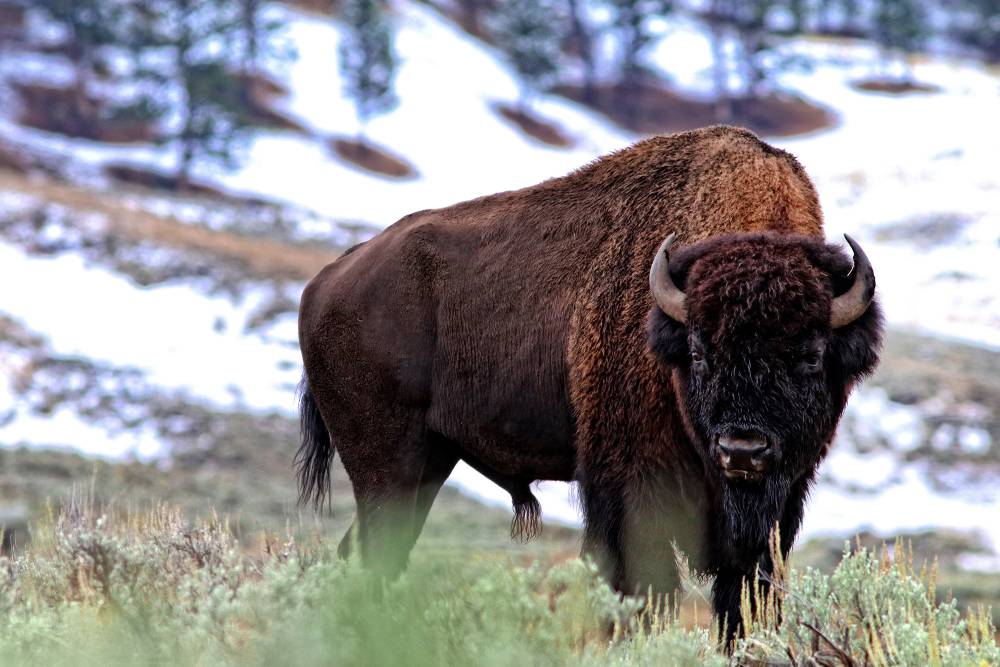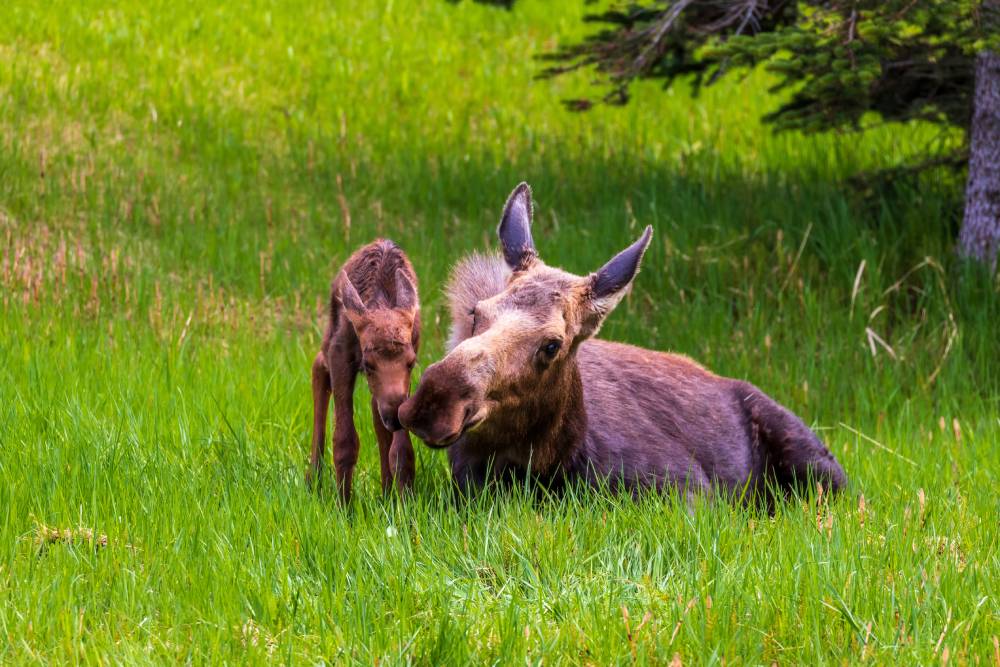State Animals of the Western United States
Sabrina Colonna
The last portion of our feature on state animals lands us in the West. From the majestic Rockies to the southwestern desert to the coast of the Pacific Ocean, this region is very geographically diverse. It's also home to a wide variety of critters. There are plenty that can only be found in certain states, as well. Learn about some of them below.
Check out the state animals in the Northeast!
Check out the state animals in the Midwest!
Check out the state animals in the South!
New Mexico — Black Bear
 Photo: Adobe Stock/Wirestock
Photo: Adobe Stock/Wirestock
To start us off with our Western state animal, we have another designation of the black bear. Many of us non-New Mexican natives may not know that the origin of Smokey Bear was based in New Mexico. The most famous bear in U.S. history was found injured in a tree while still a cub after a 17,000-acre forest fire in the Lincoln National Forest in New Mexico. In 1950, this bear was adopted by the U.S. Forest Service and the Advertising Council as the new symbol and spokes-bear for forest fire prevention and awareness in the country. Smokey Bear remained a symbol even after his death in 1975, when he was buried in Smokey Bear State Park in Captain, NM. He was further memorialized in 1963, when the American black bear was officially selected as the state animal.
Colorado — Rocky Mountain Bighorn Sheep
 Photo: Adobe Stock/Dan Ross
Photo: Adobe Stock/Dan Ross
Colorado is another state that was inspired by the unique animals that roam their state parks, designating the Rocky Mountain bighorn sheep as the state animal in 1961. As the name suggests, bighorn sheep have massive, curled horns that can grow up to 50 inches long! These sheep are only found in the Rockies, preferring very rugged and rocky terrain. Unlike deer or elk, the bighorn sheep do not shed their horns annually. In fact, the horns continue to grow over the sheep's lifetime, with an adult pair of horns weighing about 30 pounds. Due to unregulated hunting, the bighorn sheep now find themselves protected under the Endangered Species Act, with one subspecies of bighorn pushed to complete extinction.
Wyoming — Bison
 Photo: Adobe Stock/Todd S. Roach
Photo: Adobe Stock/Todd S. Roach
The bison was adopted as Wyoming's state animal in February of 1985. The bison, also referred to as the buffalo, is the state animal for Kansas and Oklahoma as well! These beautiful creatures can weigh over 1800 pounds, with their thick coats of fur able to protect them from the elements. Yellowstone National Park, which spans through Montana, Wyoming and Idaho, is the only place in the U.S. where bison have consistently lived since prehistoric times. The bison that roam Yellowstone are particularly unique because they have no cattle genes, making them direct descendants of the early bison that spanned the country's grasslands.
Montana — Grizzly Bear
Native to the beautiful Glacier National Park in Montana, the grizzly bear has represented the state since 1983. Designated through seemingly the largest pool of students yet, more than 55,000 children in 425 different schools participated in the election for Montana's state animal, where students went all in canvassing for their favorite animal through posters, speeches, campaign buttons, bumper stickers, and much more. The grizzly is the largest carnivore in the U.S., with an adult bear reaching 8 feet tall while standing on his back legs and weighing around 1,500 pounds. If that wasn't intimidating enough, the average grizzly can run 35 miles an hour! Despite their large size, conservationists believe fewer than 1,000 grizzly bears remain in the western United States.
Idaho — Appaloosa
 Photo: Pixabay/Sven Lachmann
Photo: Pixabay/Sven Lachmann
Idaho has selected many different state animals over the years, including their state horse - the appaloosa! These beautiful horses are typically recognizable by their spotted coats, striped hooves, and white markings around their eyes. Believed to be a hardy range horse with an athletic build, the appaloosa is currently one of the most popular horse breeds in America. After its designation in 1975, Idaho became the first state to offer customizable license plates that feature their state horse.
Utah — Elk
 Photo: Adobe Stock/Stepping Stones
Photo: Adobe Stock/Stepping Stones
Elk are members of the deer family and typically associate with the other deer and moose in Utah. These sweet animals once spanned across the U.S., but due to overhunting, are now only found west of the Rocky Mountains. Though Indigenous communities prized the elk for their meat and leather, European settlers soon began hunting the creatures for sport. The elk's canine teeth were claimed as trophies, with many hunters seeking out the deaths of these animals for that reason alone. Without the influence and impact of humans, elk herds will thrive anywhere with the basic necessities: water, food, and shelter. They feed primarily on grasses, but enjoy nibbling on berries, mushrooms, and wildflowers to help build up fat for the winters.
Arizona — Cactus Wren
 Photo: Pixabay/David Mark
Photo: Pixabay/David Mark
The cactus wren was designated Arizona's state bird in 1931, and remains one of the most recognizable symbols of the state. The wren has an affinity for saguaros, a species of cacti that only grows in Arizona, but can also be found around yucca and mesquite. They live in burrows inside of cacti, or areas on the cactus where the spines provide enough protection for a nest. They munch on all types of insects from ants to beetles to wasps, and occasionally divulge on seeds and fruit. A true bird of the desert, the cactus wren obtains most of its water from the food it eats, rarely seeking out and drinking from free standing water.
California — Grizzly Bear
 Photo: Pixabay/ArthurTopham
Photo: Pixabay/ArthurTopham
Although the grizzly bear was chosen as California's state animal in 1953, the giant carnivore has since gone extinct in the state. As civilization began to spread through California, grizzly bears held strong for the claim on the territory. Killing livestock and impacting settlers, the grizzlies were seen as a nuisance preventing advancement. Soon, every single grizzly bear in California was tracked down and killed, with the last standing its ground in Tulare County in 1922. Grizzly bears still remain absent from the state, but some are now trying to push for reintroduction from populations taken from neighboring states.
Nevada — Desert Bighorn Sheep
 Photo: Pixabay/Mike Goad
Photo: Pixabay/Mike Goad
Slightly different from Colorado's Rocky Mountain bighorn sheep, the desert bighorn sheep is native to Nevada's mountainous desert. These sheep are smaller than their Rocky Mountain counterparts, but tend to grow wider horns. Accustomed to the desert climate, these sheep can go extended periods of time without water, and their padded hooves allow them to climb steep, rocky terrain with agility. The bighorn sheep are also known to have excellent vision, easily able to spot predators such as coyotes, bobcats, and mountain lions. Though both male and female desert bighorns begin growing their horns soon after birth, the male horns tend to be much larger and curl while the female horns are lighter and straight. These adaptable sheep use their horns as tools to break open cacti as well as weapons in their fights.
Oregon — Beaver
 Photo: Adobe Stock/Yury Zap
Photo: Adobe Stock/Yury Zap
Sharing its state animal with New York, Oregon designated the beaver in 1961. Although they faced tumultuous times due to fur trappers, beavers have since been restored to many Oregon waters thanks to increased education, improvements in conservation management, and a decrease in fur demand. Fur trappers were the first non-Natives to settle in Oregon, and the lack of regulation quickly got out of hand. Thankfully, Oregon was quicker to act than some other states, starting beaver trapping restrictions in 1893. By 1937, beaver management was directed to the State Game Commissions, now known as the Oregon Department of Fish and Wildlife, which has maintained care for the beavers ever since. Not only does the beaver hold the title of Oregon's state animal, but can also be found on the reverse side of Oregon's flag and is the mascot of Oregon State University.
Washington — Olympic Marmot
A marmot is a burrowing animal belonging to the rodent and squirrel families. Often referred to as the "giant squirrel," marmot facial features are very similar to that of squirrels. Their bodies are rounder and covered with thick silver-brown fur with a bushy tail. The species of marmot that is indigenous to Washington is the Olympic marmot, though the 14 other marmot species can be found throughout North America, Europe, and even the Siberian region of Russia. Designated recently in May of 2009, less than 2,000 Olympic marmot now live in Olympic National Park, where they are protected by state laws. They feast on grass, berries, mosses, lichens, and flowers, digging elaborate burrows that serve as underground tunnels safe from most predators. These little critters are unique in that they hibernate for 8 months
Alaska — Moose
Alaska and Maine are like-minded, as both have the moose as their state mammal. This became official in Alaska in 1998 when then-Governor Tony Knowles signed the designation into law. The large ungulates roam Alaska from the Unuk River in the southeast to the Arctic Slope. They're most often found in second-growth birch forests, on timberline plateaus, and along major rivers in the south central and interior parts of the state. Alaskan moose are the largest subspecies of moose, reaching weights of up to 1,600 pounds and heights of up to seven feet. Meanwhile, their impressive antlers weigh in at an average of 45-50 pounds but can get as heavy as 75 pounds. They're also so well-suited to Alaskan winters that scientists have not yet been able to find at which temperature they begin to expend energy to stay warm.
Hawai'i — Hawaiian Monk Seal
 Photo: Adobe Stock/melissa
Photo: Adobe Stock/melissa
Hawai'i's state animal is one that is only found in their state: the Hawaiian monk seal. It became the state mammal in 2008, with state officials hoping that this designation would remind people of the importance of protecting them. The Hawaiian monk seal is one of the most endangered seal species in the world. Their numbers have been falling since the late 1950s, primarily due to low juvenile survival rates. While there has been an uptick recently, their current population is only about a third of what it once was. There is hope that things will continue to improve, though, with the population rising by about 2% on average each year between 2013 and 2019. Unlike other seals, the Hawaiian monk seal is mostly solitary. Despite that, they're not overly territorial. They can also be very long-lived, with some individuals surpassing 30 years of age.
To learn more about the incredible creatures that roam the U.S., check out the state animals of the Northeastern, Midwestern, and Southern states!


 Photo:
Photo: 